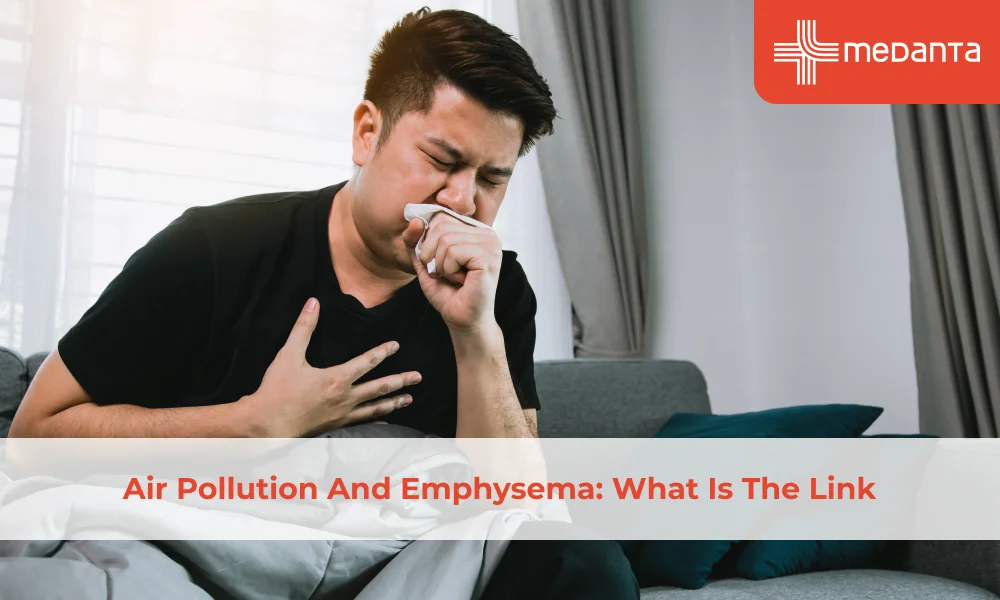Air Pollution And Emphysema: What Is The Link

TABLE OF CONTENTS
Emphysema is a type of chronic lung disease that causes shortness of breath. It is a kind of Chronic Obstructive Pulmonary Disease (COPD) and accelerates when exposed to air pollution.
What Is Emphysema?
Emphysema occurs when the linings of your lungs are damaged beyond repair. The tissues between the air sacs in your lungs form air pockets, which trap the air, making it difficult to breathe.
Most people who have emphysema also have chronic bronchitis, which is an inflammation of the tubes that carry air to your lungs.
What Causes Emphysema?
The major contributing factors to Emphysema are:
Long-term exposure to air pollution
Smoking
Chemicals, vehicular fumes, and dust
According to a recent study by the National Institute of Environmental Health Sciences (NIEHS) and the National Heart, Lung, and Blood Institute (NHLBI), long-term exposure to airborne irritants due to rising levels of air pollution is a major cause of increased cases of Emphysema.
Air Pollution and Emphysema: What Is The Link?
Long-term exposure to air pollution has been linked with the progression of emphysema between 2000 and 2018 and is expected to rise alarmingly in the coming years.
“The combined health effect of multiple air pollutants ̶ ozone, fine particles known as PM2.5, nitrogen oxides, and black carbon ̶ was greater than when the pollutants were assessed individually,” said Bonnie Joubert, Ph.D., a scientific program director at NIEHS.
Let’s look at what each of these pollutants does to our respiratory health:
Ozone and its Health Effects
Ozone can be harmful if it is present at the ground-level atmosphere. It can trigger a variety of health problems, especially in children, the elderly, and pregnant women.
As opposed to stratospheric ozone, which protects us from the harmful ultraviolet rays of the sun, ground-level ozone is formed by reactions from vehicular emissions, industrial boilers and power plants – making it harmful for our health.
Ground-level ozone can constrict the muscles in your airways, leading to a number of respiratory difficulties like:
Shortness of breath and wheezing
Coughing, sore and itchy throat
Inflamed airways
Aggravate lung conditions like emphysema, asthma, and bronchitis
Make the lungs more prone to infections
Continue to damage the lungs even when there are no symptoms
Cause COPD, or Chronic Obstructive Pulmonary Disorder
Particulate Matter and its Health Effects
Particle pollution or particulate matter is pollution caused due to suspended particles in the environment. They may be in solid or liquid droplets and can cause major respiratory illnesses.
The size of particulate matter is linked to their potential for causing respiratory issues. Finer the particles (PM2.5), higher the risk. These fine particles can penetrate deep into the lungs and may even enter the bloodstream.
Particulate matter, specifically PM2.5, can cause respiratory issues like:
Premature death in people with a heart or lung disease
Non-fatal heart attacks
Irregular heartbeat
Decreased lung function
Increased respiratory symptoms like wheezing, coughing, and shortness of breath
Aggravated symptoms of Asthma, emphysema, and chronic bronchitis
Nitrogen Oxide and Its Health Effects
Nitrogen oxides are released into the atmosphere from vehicular emissions, burning of coal, oil, diesel, and natural gas. Cigarettes, cooking stoves, and wood-burning also emit them.
Breathing nitrogen oxide can lead to respiratory difficulties like:
Coughing, wheezing, itchy throat
Nausea and headache
Difficulty breathing
Abdominal pain
Aggravated symptoms of asthma, emphysema, and chronic bronchitis
Swelling of the throat
Increased respiratory infections






